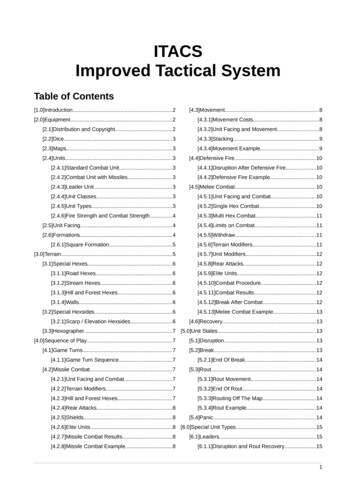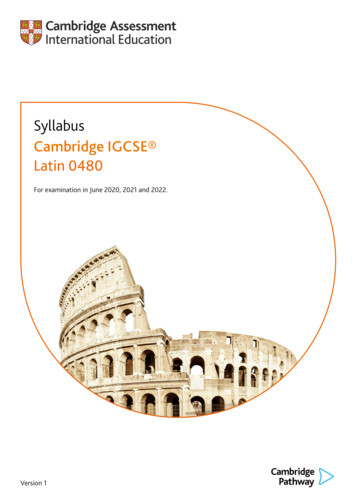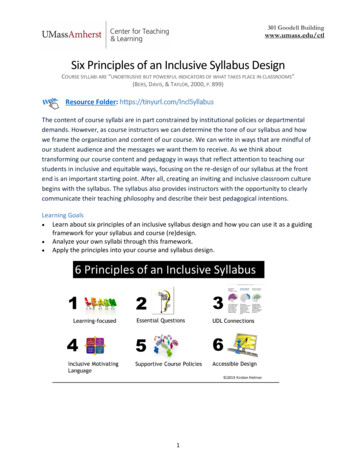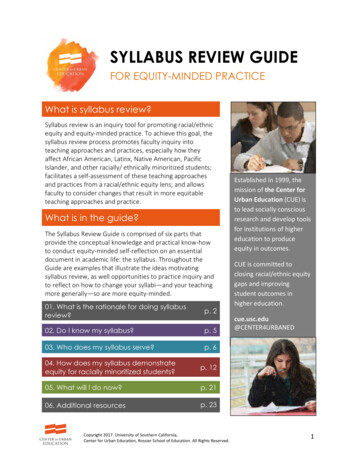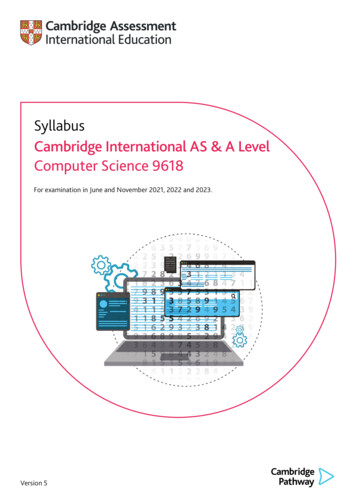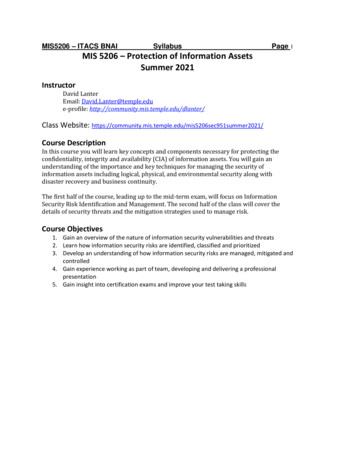
Transcription
MIS5206 – ITACS BNAISyllabusPage 1MIS 5206 – Protection of Information AssetsSummer 2021InstructorDavid LanterEmail: David.Lanter@temple.edue-profile: http://community.mis.temple.edu/dlanter/Class Website: er2021/Course DescriptionIn this course you will learn key concepts and components necessary for protecting theconfidentiality, integrity and availability (CIA) of information assets. You will gain anunderstanding of the importance and key techniques for managing the security ofinformation assets including logical, physical, and environmental security along withdisaster recovery and business continuity.The first half of the course, leading up to the mid-term exam, will focus on InformationSecurity Risk Identification and Management. The second half of the class will cover thedetails of security threats and the mitigation strategies used to manage risk.Course Objectives1. Gain an overview of the nature of information security vulnerabilities and threats2. Learn how information security risks are identified, classified and prioritized3. Develop an understanding of how information security risks are managed, mitigated andcontrolled4. Gain experience working as part of team, developing and delivering a professionalpresentation5. Gain insight into certification exams and improve your test taking skills
MIS5206 – ITACS BNAISyllabusPage 2Textbook and ReadingsTextbookISACASANSComputer and Information Security Handbook - Third Edition, 2017, John R. Vacca,Elsevier, Inc. ISBN: 978-0-12-803843-7Vacca, Chapter 16 (online) “Local Area Network Security”Vacca, Chapter 27 (online) “Information Technology Security Management”Vacca, Chapter 46 “Data Encryption”Vacca, Chapter 59 (online) “Identity Theft – First Part”Vacca, Chapter 59 (online) “Identity Theft – Second Part”Vacca, Chapter 61 (online) “SAN Security”ISACA Reading 1: ISACA Risk IT FrameworkISACA Reading 2: “Disaster Recovery and Business Continuity Planning: Testing anOrganization’s Plans”ISACA Reading 3: “What Every IT Auditor Should Know About Backup and Recovery”,SANS Reading 1: “The Importance of Security Awareness Training”SANS Reading 2: “Making Security Awareness Work for You”SANS Reading 3: “Implementing Robust Physical BP)Misc.SANS Reading 4: “An Overview of Cryptographic Hash Functions and Their Uses”SANS Reading 5: “The Risks Involved With Open and Closed Public KeyInfrastructure”SANS Reading 6: “Assessing Vendor Application Security A PracticalWay to Begin”SANS Reading 7: “Application Development Technology and Tools: Vulnerabilities andthreat management with secure programming practices, a defense in-depth approach”FIPS Reading 1: “Standards for Security Categorization of Federal Information andInformation Systems”NIST Reading 1: “Framework for Improving Critical Infrastructure Cybersecurity”FGDC Reading 1: “Guidelines for Providing Appropriate Access to Geospatial Data inResponse to Security Concerns”2 case studies and 1 reading are available in the course pack for purchase from HBP:https://hbsp.harvard.edu/import/824815Case Study 1: “Snowfall and a Stolen Laptop”Case Study 2: “Autopsy of a Data Breach: The Target Case”HBR Reading 1: “The Myth of Secure Computing (HBR OnPoint Enhanced Edition)”Case Study 3: “A Hospital Catches the “Millennium Bug”
MIS5206 – ITACS BNAISyllabusPage 3Schedule of class topics:Unit #0a0b1a1b2a2b3a3b4a4b5a5b6a6b7a7b89Assignment TopicsVideo – Introduction to MIS5206Videos - Understanding an Organization’s Risk EnvironmentCase Study 1: Snowfall and a stolen laptopData Classification Process and ModelsRisk EvaluationCase Study 2: Autopsy of a Data Breach: The Target CaseCreating a Security Aware OrganizationPhysical and Environmental SecurityMidterm ExamCase Study 3: A Hospital Catches the “Millennium Bug”Business Continuity and Disaster Recovery PlanningTeam Project AssignmentNetwork SecurityCryptography, Public Key Encryption and Digital SignaturesIdentity Management and Access ControlComputer Application Security & Team Project PresentationsTeam Project Presentations & ReviewFinal ExamAssignmentsThe readings, questions, and case study assignments will bring the real world into classdiscussion while illustrating fundamental concepts.1. Readings: Below is the reading schedule you are responsible for completing. Completeeach reading and answer reading discussion questions posted to the class websitebefore the first class:Unit#0b1a1bReadings 2a Vacca Chapter 1 “Information Security in the Modern Enterprise”Vacca Chapter 2 ” Building a Secure Organization”NIST Reading 1: “Framework for Improving Critical InfrastructureCybersecurity”ISACA Risk IT Framework, pp. 1-42Case Study 1: “Snowfall and a Stolen Laptop”Vacca Chapter 24 “Information Security Essentials for IT Managers:Protecting Mission-Critical Systems”FIPS Reading 1: “Standards for Security Categorization of FederalInformation and Information Systems”FGDC Reading 1: “Guidelines for Providing Appropriate Access toGeospatial Data in Response to Security ConcernsVacca Chapter 25 “Security Management Systems”
MIS5206 – ITACS BNAI2b3a3b4b5a 6a 6b 7a7b SyllabusPage 4Vacca Chapter 34 “Risk Management”ISACA Reading 1: “Risk IT Framework” pp. 47-96Case Study 2: ““Autopsy of a Data Breach: The Target Case”Vacca Chapter 27 (online) “Information Technology Security Management”Vacca Chapter 33 “Security Education, Training and Awareness”SANS Reading 1: “The Importance of Security Awareness Training”SANS Reading 2: “Making Security Awareness Work for You”HBR Reading 1: “The Myth of Security Computing”Vacca Chapter 69 “Physical Security Essentials”SANS Reading 3: “Implementing Robust Physical Security”Case Study 3: “A Hospital Catches the “Millennium Bug”Vacca Chapter 61 (online) “SAN Security”Vacca Chapter 62 “Storage Area Networking Security Devices”Vacca Chapter 36 “Disaster Recovery”Vacca Chapter 37 “Disaster Recovery Plans for Small and Mediumbusinesses”ISACA Reading 2: “Disaster Recovery and Business Continuity Planning:Testing an Organization’s Plans”ISACA Reading 3: “What Every IT Auditor Should Know About Backup andRecovery”Vacca Chapter 8 “Guarding Against Network Intrusions”Vacca Chapter 13 “Internet Security”Vacca Chapter 14 “The Botnet Problem”Vacca Chapter 15 “Intranet Security”Vacca Chapter 16 (online) “Local Area Network Security”Vacca Chapter 72 “Intrusion Prevention and Detection Systems”Vacca Chapter 46 (online) “Data Encryption”Vacca Chapter 47 “Satellite Encryption”Vacca Chapter 48 “Public Key Infrastructure”Vacca Chapter 51 “Instant-Messaging Security”SANS Reading 4: “An Overview of Cryptographic Hash Functions and TheirUses”SANS Reading 5: “The Risks Involved With Open and Closed Public KeyInfrastructure”Vacca Chapter 71 “Online Identity and User Management Services”Vacca Chapter 52 “Online Privacy”Vacca Chapter 53 “Privacy-Enhancing Technologies”Vacca Chapter 59 “Identity Theft – First Part”Vacca Chapter 59 “Identity Theft – Second Part”SANS Reading 6: “Assessing Vendor Application Security A PracticalWay to Begin”SANS Reading 7: “Application Development Technology and Tools:Vulnerabilities and threat management with secure programmingpractices, a defense in-depth approach”
MIS5206 – ITACS BNAISyllabusPage 52. Answer Questions: Questions for each topical unit are available on the class website,under “QUESTIONS ABOUT THE READINGS AND CASE STUDIES. Post your answer toeach of the questions as you work through the readings with the goal of completionbefore first day of class June 1. To do so, click “Leave a Comment”. Provide a paragraphor two of thoughtful analysis as your answer to each question. Late submissions ofanswers will result in lost credit for the assignment.Post your answers to the assignments, and come to class prepared to discuss all of youranswers in-detail.Case Studies: Case study analysis will be conducted in three phases:i.Individual preparation is done as homework assignment questions you answer that willprepare you to contribute in group discussion meetings. It will prepare you to learn from whatothers say. To fully benefit from the interchange of ideas about a case’s problem, however,you must possess a good understanding of the facts of the case and have your own ideas.Studying the case, doing your homework and answering the questions readies you to react towhat others say. This is how we learn.Group discussions are informal sessions of give and take. Come with your own ideas andleave with better understanding. By pooling your insights with the group you advance yourown analysis. Discussions within small groups is also helpful for those uncomfortable talkingin large classes to express their views and gain feedback.Class discussion advances learning from the case, but does not solve the case. Rather it helpsdevelop your understanding why you need to gain more knowledge and learn concepts thatprovide the basis of your intellectual toolkit you develop in class and apply in practice.ii.iii.Below is the schedule for the Case Studies:UnitCase Studies1a Case Study 1: Snowfall and a stolen laptop2b Case Study 2: Autopsy of a Data Breach: The Target Case4b Case Study 3: A Hospital Catches the “Millennium Bug”ParticipationYour participation in class discussions is critical. Evaluation is based on you consistentlydemonstrating your thoughtful engagement with the material. Assessment is based onwhat you contribute. The frequency and quality of your contributions are equallyimportant.Team Projects PresentationDuring Unit #5b students will be organized into project teams. Each team will receive a topic,and will follow up by developing a presentation covering the assigned topic. During Unit #8each team will have a total time of 15 minutes to present their topic, following by questionsand answer (Q&A) session.ExamsThere will be two exams given during the semester. Together these exams are weighted25% of each student’s final grade.
MIS5206 – ITACS BNAISyllabusPage 6Below is the exam schedule:Unit #4a9ExamMidterm ExamFinal ExamBoth exams will consist of multiple-choice questions. You will have a fixed time (e.g. 120minutes) to complete the exam. The Midterm Exam will occur during Unit #3a and the FinalExam will occur after the last class.A missed exam can only be made up in the case of documented and verifiable extremeemergency situation. No make-up is possible for the Final Exam.QuizzesAt the end of many class units I will provide you with a test taking tip followed by a practicequiz consisting of multiple choice questions modeled after the content of the CISAcertification exam. Quizzes are for practice only. They will not count towards your finalgrade. You will be given time to answer the quiz, and then we will go over the answers tothe quiz. The goals for the quizzes are twofold: 1) help you become familiar with technicalinformation security areas requiring additional study and attention, and 2) help you gainskills that improve your test taking abilities.Evaluation and GradingItemAssignmentsParticipationTeam Project PresentationExamsGrading ScaleWeight25%25%25%25%100%94 – 10090 – 9387 – 8983 – 8680 – 8277 – 79AAB BBC 73 – 7670 – 7267 – 6963 – 6660 – 62Below 60CCD DDFGrading CriteriaThe following criteria are used for evaluating assignments. You can roughly translate aletter grade as the midpoint in the scale (for example, an A- equates to a 91.5).CriteriaGradeThe assignment consistently exceeds expectations. It demonstrates originalityof thought and creativity throughout. Beyond completing all of the requiredelements, new concepts and ideas are detailed that transcend generaldiscussions along similar topic areas. There are no mechanical, grammatical, ororganization issues that detract from the ideas.A- or AThe assignment consistently meets expectations. It contains all the informationprescribed for the assignment and demonstrates a command of the subjectmatter. There is sufficient detail to cover the subject completely but not tooB-, B, B
MIS5206 – ITACS BNAISyllabusPage 7much as to be distracting. There may be some procedural issues, such asgrammar or organizational challenges, but these do not significantly detractfrom the intended assignment goals.The assignment fails to consistently meet expectations. That is, the assignmentis complete but contains problems that detract from the intended goals. Theseissues may be relating to content detail, be grammatical, or be a general lack ofclarity. Other problems might include not fully following assignment directions.C-, C, C The assignment constantly fails to meet expectations. It is incomplete or insome other way consistently fails to demonstrate a firm grasp of the assignedmaterial.BelowC-Late Assignment PolicyAn assignment is considered late if it is turned in after the assignment deadlines statedabove. No late assignments will be accepted without penalty unless arrangements forvalidated unusual or unforeseen situations have been made. The exercise assignments will be assessed a 20% penalty each day they are late.No credit is given for assignments turned in over five calendar days past the due date. You must submit all assignments, even if no credit is given. If you skip anassignment, an additional 10 points will be subtracted from your final grade inthe course. Plan ahead and backup your work. Equipment failure is not an acceptable reasonfor turning in an assignment late.TEMPLE AND COVID-19Temple University’s motto is Perseverance Conquers, and we will meet the challenges of theCOVID pandemic with flexibility and resilience. The university has made plans for multipleeventualities. Working together as a community to deliver a meaningful learning experienceis a responsibility we all share: we’re in this together so we can be together.Attendance Protocol and Your HealthInstructors are required to ensure that attendance is recorded for each in-personor synchronous class session. The primary reason for documentation of attendance is tofacilitate contact tracing, so that if a student or instructor with whom you have had closecontact tests positive for COVID-19, the university can contact you. Recording of attendancewill also provide an opportunity for outreach from student services and/or academicsupport units to support students should they become ill. Faculty and students agree to actin good faith and work with mutual flexibility. The expectation is that students will behonest in representing class attendance.Video Recording and Sharing PolicyAny recordings permitted in this class can only be used for the student’s personaleducational use. Students are not permitted to copy, publish, or redistribute audio or videorecordings of any portion of the class session to individuals who are not students in thecourse or academic program without the express permission of the faculty member and ofany students who are recorded. Distribution without permission may be a violation ofeducational privacy law, known as FERPA as well as certain copyright laws. Any recordings
MIS5206 – ITACS BNAISyllabusPage 8made by the instructor or university of this course are the property of Temple University.Any unauthorized redistribution of video content is subject to review by the Dean’s office,and the University Disciplinary Committee. Penalties can include receiving an F in thecourse and possible expulsion from the university. This includes but is not limited to:assignment video submissions, faculty recorded lectures or reviews, class meetings (live orrecorded), breakout session meetings, and more.Code of Conduct Statement for Online Classes Online BehaviorStudents are expected to be respectful of one another and the instructor in onlinediscussions. The goal is to foster a safe learning environment where students feelcomfortable in discussing concepts and in applying them in class. If for any reason yourbehavior is viewed as disruptive to the class, you will be asked to leave and you will bemarked absent from that class. Please read the university policy concerning disruptivebehavior:The disruptive student is one who persistently makes inordinate demands fortime and attention from faculty and staff, habitually interferes with the learningenvironment by disruptive verbal or behavioral expressions, verbally threatensor abuses college personnel, willfully damages college property, misuses drugsor alcohol on college premises, or physically threatens or assaults others. Theresult is the disruption of academic, administrative, social, or recreationalactivities on campus.Online Classroom EtiquetteThe expectation is that students attending online courses will behave in the same manner asif they were in a live classroom. Be courteous and professional in your location, attire andbehavior. Specifically, your location should reflect a clean and professional appearance not a bedroom, crowded conference room, loud restaurant/bar, etc. Your attire shouldmirror what you might wear to a live classroom. We expect that students will not disruptclass through visuals or verbal outbursts, such as but not limited to, conversations withother people in the room, engaging in inappropriate behavior while you are in class ordistracting the class in any other way. In addition, students should refrain from doingsomething in their online class that they would not do in a live classroom. which includeseating large meals, drinking alcohol, vaping, getting up often and leaving the online class(not staying at their computer). You should arrive on time and leave when the class is over.If there is an emergency of some kind, notify your faculty member via email or the chatfunction in Zoom.Online exam proctoringProctorio or a similar proctoring tool may be used to proctor exams or quizzes in thiscourse. These tools verify your identity and record online actions and surroundings. It isyour responsibility to have the necessary government or school issued ID, a laptop ordesktop computer with a reliable internet connection, the Google Chrome and Proctorioextension, a webcam/built-in camera and microphone, and system requirements for usingProctorio or a similar proctoring tool. Before the exam begins, the proctor may require ascan of the room in which you are taking the exam.
MIS5206 – ITACS BNAISyllabusPage 9Student and Faculty Academic Rights & ResponsibilitiesFreedom to teach and freedom to learn are inseparable facets of academic freedom.The University has a policy on Student and Faculty Academic Rights and Responsibilities(Policy #03.70.02) which can be accessed at policies.temple.edu.Inclement Weather PolicyPlease be advised that while Temple University campuses may close for inclement weather,online courses are not on-campus and therefore are still expected to meet. Your instructorwill contact you regarding any adjustments needed in the event of a power outage or severecircumstances. Should you have any questions, please contact the professor.Academic HonestyLearning is both an individual and a cooperative undertaking. Asking for and giving helpfreely in all appropriate setting helps you to learn. You should represent only your ownwork as your own. Personal integrity is the basis for intellectual and academic integrity.Academic integrity is the basis for academic freedom and the University's position ofinfluence and trust in our society. University and school rules and standards define andprohibit "academic misconduct" by all members of the academic community includingstudents. You are asked and expected to be familiar with these standards and to abide bythem. A link to Temple’s Policy on Academic Dishonesty can be found at the following oceduresDisability StatementAny student who has a need for accommodations based on the impact of a documenteddisability or medical condition should contact Disability Resources and Services (DRS) in100 Ritter Annex (drs@temple.edu; 215-204-1280) to request accommodations and learnmore about the resources available to you. If you have a DRS accommodation letter to sharewith me, or you would like to discuss your accommodations, please contact me as soon aspractical. I will work with you and with DRS to coordinate reasonable accommodations forall students with documented disabilities. All discussions related to your accommodationswill be confidential.Temple University’s Technology Usage PolicyThis site includes information on unauthorized access, disclosure of passwords, and sharingof accounts. /policies/04.71.11.pdf
MIS5206 - ITACS BNAI Syllabus Page 2 Textbook and Readings Textbook Computer and Information Security Handbook - Third Edition, 2017, John R. Vacca, Elsevier, Inc. ISBN: 978--12-803843-7 Vacca, Chapter 16 (online) "Local Area Network Security" Vacca, Chapter 27 (online) "Information Technology Security Management"
